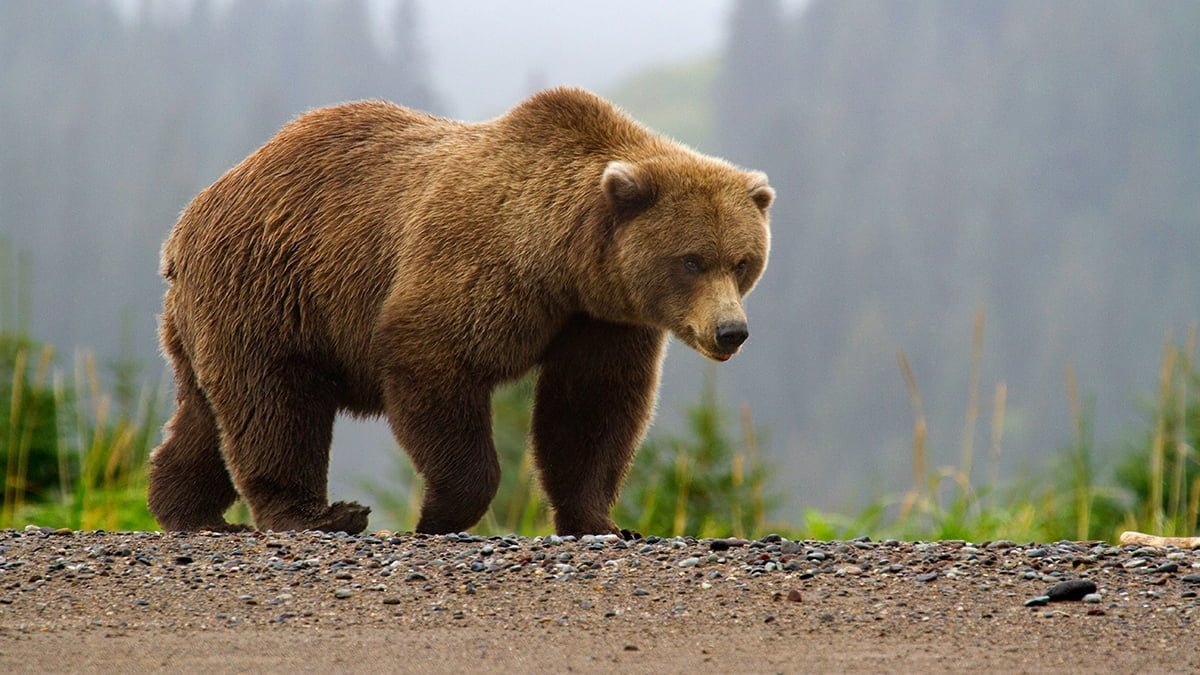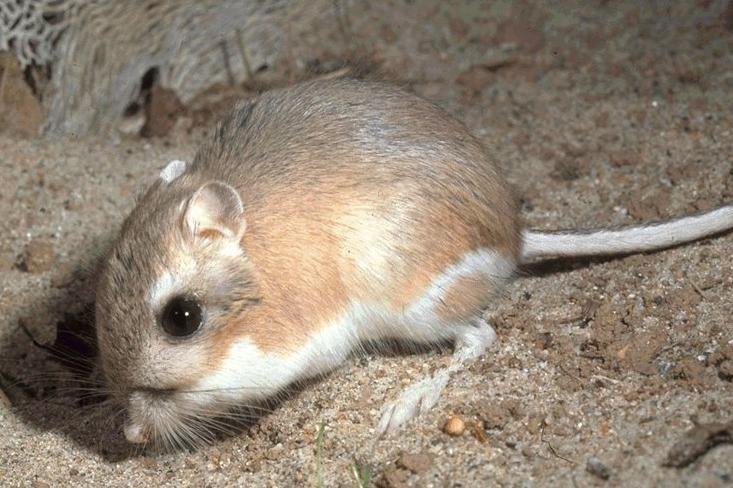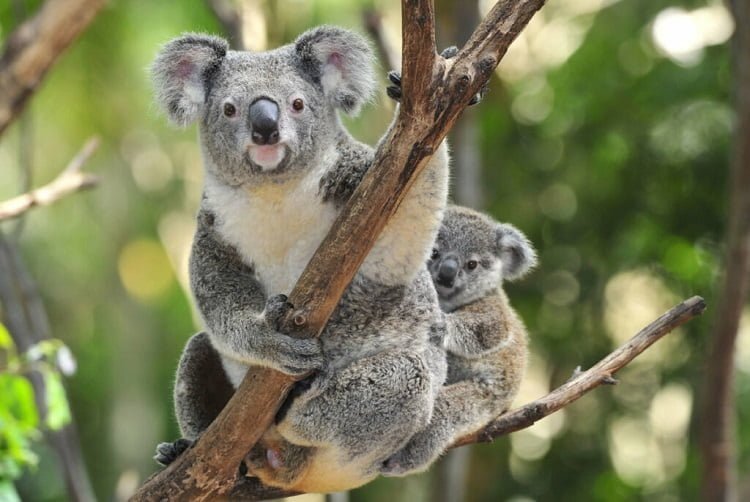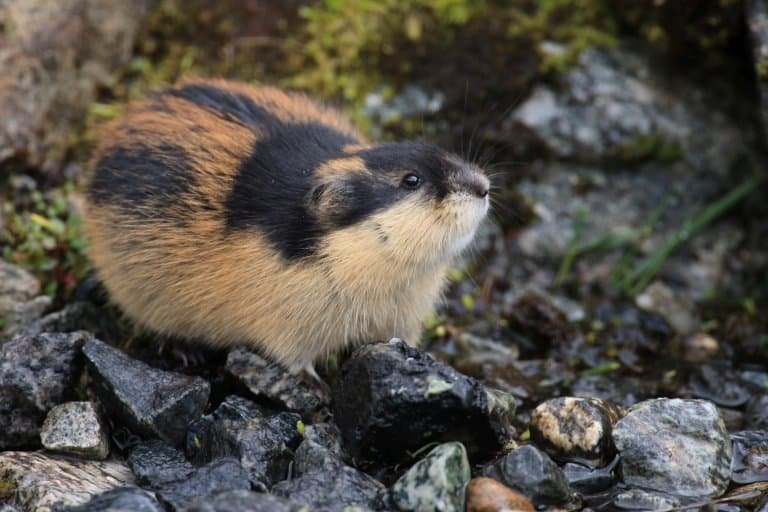Brown bear Facts, FAQs, Behaviour, Habitat and Conservation

Brown bear Facts | Description | Distribution and Habitat | Conservation | Behaviour and Ecology | Interaction with Human | Cultural | Interesting facts | frequently asked questions about Brown bear
The Brown Bear, a majestic mammal found in various parts of the world, is known for its powerful build and striking appearance. With its thick fur, sharp claws, and keen sense of smell, this formidable creature commands respect and awe from all who encounter it.
Whether prowling through the dense forests of North America, Europe, or Asia, the Brown Bear is a master of its domain, effortlessly adapting to a wide range of environments and hunting down prey with ease. But despite its fearsome reputation, this magnificent animal also possesses a softer side, as evidenced by its nurturing care of its young and its playful antics during mating season.
Whether you’re an avid wildlife enthusiast or simply intrigued by the wonders of the natural world, the Brown Bear is a creature that is sure to captivate your imagination and inspire a deep appreciation for the beauty and diversity of life on our planet. So come, join us on a journey of discovery as we explore the incredible world of the Brown Bear and all that it has to offer.
Taxonomy of Brown bear
| Kingdom | Animalia |
|---|---|
| Phylum | Chordata |
| Class | Mammalia |
| Order | Carnivora |
| Family | Ursidae |
| Genus | Ursus |
| Species | Ursus arctos |
Morphology of Brown bear
| Feature | Description |
|---|---|
| Size | Males can weigh between 150-600 kg (330-1,320 lbs) and stand 1.4-2.8 m (4.6-9.2 ft) tall on hind legs. Females are smaller, typically weighing between 80-250 kg (180-550 lbs) and standing 1.3-2.4 m (4.3-7.9 ft) tall. |
| Fur | Thick, shaggy fur that can range in color from blonde to dark brown. Some subspecies have white-tipped fur or a “grizzled” appearance. |
| Head | Large and broad, with small eyes and rounded ears. |
| Teeth | Powerful jaws and sharp teeth, including long canine teeth for gripping and tearing prey. |
| Claws | Long, curved claws that are non-retractable and used for digging, climbing, and catching prey. |
| Paws | Large, broad paws with five toes and tough, leathery pads for walking on rough terrain and swimming. |
| Tail | Short and stubby, typically measuring only 10-20 cm (4-8 in) in length. |
| Overall Shape | Thickset and muscular, with a hump of muscle on the shoulders and a concave profile on the face. |

Description of Brown bear
The Brown Bear, also known as the grizzly bear, is a large mammal found in North America, Europe, and Asia. It is characterized by its thick fur, which can range in color from blonde to dark brown, and its broad, powerful build. Brown Bears are typically between 1.4-2.8 m (4.6-9.2 ft) tall on their hind legs, and males can weigh up to 600 kg (1,320 lbs), making them one of the largest carnivores in the world.
The Brown Bear’s head is large and rounded, with small eyes and rounded ears. Its jaws are powerful and equipped with sharp teeth, including long canine teeth for gripping and tearing prey. The Brown Bear’s claws are long, curved, and non-retractable, and are used for digging, climbing, and catching prey.
Brown Bears are adaptable and can thrive in a range of environments, from dense forests to open grasslands. They are omnivorous, meaning they eat both plants and animals, and will hunt a range of prey, including fish, small mammals, and even larger animals like moose and elk.
Despite their fearsome reputation, Brown Bears are also known for their nurturing care of their young and their playful behavior during mating season. They will typically hibernate during the winter months, relying on stored fat reserves to survive until spring.
In summary, the Brown Bear is a fascinating and formidable creature that has captured the imaginations of people around the world for generations. Its physical adaptations and behaviors have allowed it to thrive in a variety of environments and make it a vital part of many ecosystems.
Distribution and habitat of Brown bear
The Brown Bear is a widespread species that can be found across the Northern Hemisphere. They are native to North America, Europe, and Asia and can be found in a variety of habitats, from dense forests to open tundra.
In North America, Brown Bears are found throughout Alaska and parts of Canada, with smaller populations in the lower 48 states of the United States, including Montana, Wyoming, and Idaho. In Europe, Brown Bears are found in Scandinavia, Russia, and the Carpathian Mountains in Central Europe. In Asia, they are found in Russia, China, and parts of the Middle East.
Brown Bears have adapted to a range of different habitats, including coastal areas, forests, grasslands, and mountainous regions. They prefer areas with abundant food sources, such as salmon-rich rivers in coastal regions or berry patches in forested areas.
During the winter months, Brown Bears will often hibernate in dens they have excavated themselves, usually in a hillside or cave. These dens provide insulation and protection from the cold temperatures and harsh weather.
Human activity has had a significant impact on the distribution and habitat of Brown Bears, with habitat loss and fragmentation being major threats to the species. Conservation efforts, such as habitat protection and bear-proofing measures, have been successful in some areas in helping to preserve Brown Bear populations.
Behaviour and Ecology of Brown bear
Brown Bears are solitary animals, except during mating season and when a mother is caring for her young. They are primarily active during the day and have excellent senses of hearing and smell, which they use to locate food and detect predators.
As opportunistic omnivores, Brown Bears have a varied diet that includes fish, insects, berries, nuts, roots, and small mammals. In some areas, they may also prey on larger animals like moose or caribou. Brown Bears are known for their fishing ability, and they will often catch salmon during their migration upriver to spawn.
During the winter months, Brown Bears will hibernate in dens, where they will survive on stored body fat until spring. Pregnant females will typically give birth to one to four cubs in their den during hibernation, and the cubs will remain with their mother for up to two years.
Brown Bears are important keystone species in many ecosystems, playing a vital role in regulating prey populations and maintaining healthy plant communities. They are also known to influence nutrient cycling by moving salmon carcasses and other prey throughout their habitat.
Human activity has had a significant impact on the behavior and ecology of Brown Bears, with habitat loss and fragmentation being major threats to the species. Hunting and conflicts with humans have also impacted Brown Bear populations in some areas.
In areas where Brown Bears are protected, conservation efforts have been successful in helping to preserve populations and reduce conflicts with humans. These efforts include habitat protection, bear-proofing measures, and education programs to promote coexistence with these magnificent animals.
Conservation of Brown bear
Brown Bears are an important part of many ecosystems and play a vital role in regulating prey populations and maintaining healthy plant communities. However, human activity has had a significant impact on Brown Bear populations, with habitat loss, fragmentation, and hunting being major threats to the species.
Conservation efforts to protect Brown Bears have been successful in some areas. Habitat protection is a key strategy, as it provides areas for Brown Bears to live and breed without human disturbance. In some areas, bear-proofing measures have also been implemented to prevent bears from coming into conflict with humans.
In addition to habitat protection, hunting regulations have been put in place to limit the number of Brown Bears killed each year. Some countries, such as the United States, have established national parks and wilderness areas where hunting is prohibited, providing safe havens for Brown Bears and other wildlife.
Conservation organizations also work to educate the public about the importance of Brown Bears and their role in the ecosystem. This includes promoting coexistence with bears and advocating for policies and regulations that protect them and their habitat.
Overall, conservation efforts have been successful in helping to preserve Brown Bear populations in some areas. However, continued effort is needed to address ongoing threats to their habitat and ensure their long-term survival.
Interaction with Human of Brown bear
Brown Bears have a long history of interacting with humans. In some areas, they are revered as sacred animals and are a part of local folklore and traditions. However, in other areas, they are seen as a threat to human safety and are actively hunted or persecuted.
Human activity has had a significant impact on Brown Bear populations, with habitat loss and fragmentation being major threats to the species. Additionally, conflicts with humans can arise when bears come into contact with people, particularly in areas where humans have encroached on their habitat.
Brown Bears are generally shy and avoid humans, but they can become aggressive if they feel threatened or are defending their young. Encounters between humans and Brown Bears can result in injuries or fatalities, and it is important for people to be aware of how to act safely in bear country.
Conservation organizations work to promote coexistence between humans and Brown Bears by providing education and resources to communities living in areas where bears are present. This includes bear-proofing measures, such as securing food and garbage, and providing information on how to safely recreate in bear country.
In areas where hunting is allowed, regulations are put in place to limit the number of Brown Bears killed each year. Some countries have established national parks and wilderness areas where hunting is prohibited, providing safe havens for Brown Bears and other wildlife.
Overall, the interaction of the Brown Bear with humans is complex, and conservation efforts are needed to ensure the long-term survival of this magnificent species while promoting safe and responsible human behavior in bear country.
Cultural and Historical Significance of Brown bear
Brown Bears have been a part of human culture and history for thousands of years. They are revered as sacred animals in many indigenous cultures, and their images appear in art, mythology, and folklore around the world.
In some cultures, Brown Bears are considered to be symbols of strength, power, and courage. They are often associated with warriors, and their skins and claws have been used in ceremonial dress and adornments.
In some societies, Brown Bears have been hunted for their meat, fur, and other parts. In some cases, hunting was restricted to certain times of the year and was performed with specific rituals and ceremonies to honor the bear and ensure its continued presence.
Today, Brown Bears continue to play an important cultural and historical role in many societies. They are often featured in art, literature, and music, and are a popular subject for wildlife photographers and filmmakers.
Conservation organizations work to preserve the cultural and historical significance of Brown Bears by promoting their importance in indigenous cultures and providing education and resources to communities living in areas where bears are present.
Overall, the cultural and historical significance of the Brown Bear is a testament to the deep connection between humans and the natural world and highlights the need for continued conservation efforts to protect this magnificent species for generations to come.
Explanatory Notes for Brown bear
The Brown Bear is a large mammal that is found across a wide range of habitats, from forests and grasslands to tundra and mountainous regions. It is a member of the Ursidae family, which includes eight species of bears found around the world.
Brown Bears are characterized by their shaggy fur, which can range in color from blonde to dark brown or black. They have a large hump of muscle on their shoulders, which gives them the strength to dig and forage for food. Their sharp claws are used for digging, climbing, and catching prey, and they have a keen sense of smell that helps them locate food and identify potential predators.
Brown Bears are omnivorous, meaning they eat a variety of foods, including plants, fruits, nuts, and meat. They are opportunistic feeders and will eat whatever food is available in their habitat, including insects, fish, and small mammals.
The distribution and habitat of Brown Bears are closely tied to their ability to find food and suitable den sites. They are found across a wide range of habitats, including temperate and subarctic forests, alpine meadows, and coastal regions. They typically require large areas of undisturbed habitat to survive and reproduce successfully.
Conservation efforts to protect Brown Bears have been successful in some areas, with habitat protection and hunting regulations being key strategies. However, human activity continues to pose a significant threat to their survival, and ongoing efforts are needed to ensure their long-term survival.
Overall, the Brown Bear is a fascinating and important species that plays a vital role in many ecosystems. Its complex behavior, ecology, and interactions with humans make it a subject of ongoing scientific research and conservation efforts.
Interesting facts about Brown bear
Here are 10 interesting facts about Brown Bears:
- Brown Bears are also known as grizzly bears, due to the silver-tipped hairs on their fur that give them a grizzled appearance.
- They are excellent swimmers and can swim long distances in search of food or to escape danger.
- Brown Bears have a powerful sense of smell and can detect food from up to 20 miles away.
- They are one of the largest land mammals in North America, with adult males weighing up to 1,500 pounds.
- Brown Bears can run at speeds of up to 30 miles per hour, making them one of the fastest animals in their habitat.
- They have a unique hibernation cycle, during which they can lose up to 30% of their body weight.
- Brown Bears are highly intelligent and can solve complex problems, such as opening latches and doors to access food.
- Cubs stay with their mothers for up to three years, during which time they learn important survival skills such as hunting and foraging.
- Brown Bears play an important role in many ecosystems, helping to control populations of prey animals and aiding in the dispersal of seeds.
- Despite their formidable reputation, Brown Bears are generally not aggressive towards humans and will only attack if they feel threatened or if their cubs are in danger.
General queries or frequently asked questions about Brown bear
What is a Brown Bear?
A Brown Bear is a large mammal found across a wide range of habitats, from forests and grasslands to tundra and mountainous regions. They are characterized by their shaggy fur, which can range in color from blonde to dark brown or black, and their large hump of muscle on their shoulders.
What do Brown Bears eat?
Brown Bears are omnivorous, meaning they eat a variety of foods, including plants, fruits, nuts, and meat. They are opportunistic feeders and will eat whatever food is available in their habitat, including insects, fish, and small mammals.
Where do Brown Bears live?
Brown Bears are found across a wide range of habitats, including temperate and subarctic forests, alpine meadows, and coastal regions. They are found in North America, Europe, and Asia, and their distribution and habitat are closely tied to their ability to find food and suitable den sites.
Are Brown Bears dangerous?
Brown Bears have a formidable reputation but are generally not aggressive towards humans and will only attack if they feel threatened or if their cubs are in danger. However, it is important to exercise caution and follow safety guidelines when in bear habitat.
How can I see Brown Bears in the wild?
There are many opportunities to view Brown Bears in the wild, including guided tours and wildlife viewing areas in national parks and other protected areas. It is important to follow safety guidelines and respect the bears’ habitat when viewing them in the wild.
What is the conservation status of Brown Bears?
Brown Bears are classified as a species of “least concern” by the International Union for Conservation of Nature (IUCN), but many populations are threatened by habitat loss, hunting, and other human activities. Conservation efforts to protect Brown Bears have been successful in some areas, but ongoing efforts are needed to ensure their long-term survival.
What is the difference between a Brown Bear and a Grizzly Bear?
There is no difference between a Brown Bear and a Grizzly Bear – they are the same species, with the Grizzly Bear being a subspecies of the Brown Bear found in North America.
How do Brown Bears communicate?
Brown Bears communicate using a variety of vocalizations, including growls, grunts, and moans. They also use body language, such as standing on their hind legs, to communicate with other bears.
How long do Brown Bears live?
Brown Bears can live up to 25 years in the wild, although most live for around 20 years. Life expectancy is affected by factors such as habitat quality, food availability, and human activities.
Do Brown Bears hibernate?
Yes, Brown Bears hibernate during the winter months to conserve energy and survive the cold temperatures. They can go for up to six months without food or water during hibernation.
Conclusion
In conclusion, the Brown Bear is a fascinating and important mammal that is found across a wide range of habitats in North America, Europe, and Asia. These omnivores play an important ecological role as seed dispersers and predators, and they have also played a significant cultural and historical role in many societies. While conservation efforts have been successful in protecting some populations, many others are threatened by habitat loss, hunting, and other human activities. It is important for us to continue to study and understand these magnificent creatures to ensure their long-term survival and coexistence with humans.












